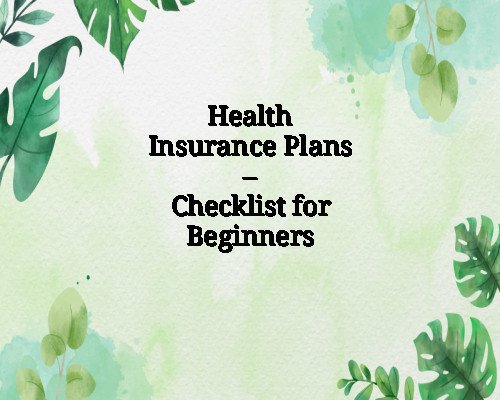Health Insurance Plans – Checklist for Beginners
Understand the key factors in choosing a health insurance plan, including coverage, premiums, deductibles, and provider networks with this beginner-friendly checklist.
Introduction to Health Insurance
Health insurance is a vital tool that protects you from overwhelming medical costs and provides access to quality healthcare. Whether you’re self-employed, working for an employer, or simply exploring options on the marketplace, understanding how to evaluate and choose a health insurance plan is essential.
Navigating through health insurance jargon, coverage types, and cost structures can be intimidating. This guide breaks down the process with a clear, beginner-friendly checklist to help you make informed decisions.
Why Health Insurance Is Important
Before diving into the checklist, it’s important to understand the significance of having a good health insurance plan:
-
Protects Against High Medical Costs: Hospitalization, surgeries, and emergency care can lead to financial ruin without coverage.
-
Access to Quality Care: Insurance ensures you can visit doctors, receive treatments, and access preventive care.
-
Mental Peace: Knowing you’re covered reduces anxiety over potential medical emergencies.
-
Tax Benefits: Depending on your country, health insurance premiums may offer tax deductions.
Step-by-Step Checklist for Beginners
1. Assess Your Healthcare Needs
Understanding your personal and family health requirements is the foundation of choosing a plan.
-
Do you visit doctors often or only during emergencies?
-
Are there any chronic illnesses or conditions requiring regular treatment?
-
Do you need access to specialists or specific medications?
-
Are you planning any major procedures, surgeries, or maternity care?
2. Understand the Types of Health Insurance Plans
Familiarize yourself with the common types of plans to know which suits your lifestyle and budget.
-
HMO (Health Maintenance Organization): Requires you to use a network of doctors and get referrals for specialists. Lower cost but less flexibility.
-
PPO (Preferred Provider Organization): Offers more provider flexibility; no referrals needed, but usually higher premiums.
-
EPO (Exclusive Provider Organization): Services covered only if you use doctors in the plan’s network (except for emergencies).
-
POS (Point of Service): Combines features of HMO and PPO. Requires referrals but allows some out-of-network coverage.
-
High Deductible Health Plan (HDHP): Lower premiums with higher deductibles; often paired with HSAs (Health Savings Accounts).
3. Compare Monthly Premiums
This is the amount you pay every month, regardless of whether you use the insurance.
-
Lower premiums might mean higher out-of-pocket costs when you need care.
-
If you visit doctors frequently, consider a plan with a higher premium and lower deductible.
4. Review the Deductible
A deductible is what you pay out-of-pocket before your insurance starts covering expenses.
-
Lower deductible = higher monthly premiums but less out-of-pocket during treatment.
-
Higher deductible = lower premiums but higher costs if you require medical care.
Match the deductible with your expected healthcare usage.
5. Understand Copayments and Coinsurance
-
Copayment (Copay): A fixed amount you pay for a service (e.g., $20 for a doctor visit).
-
Coinsurance: A percentage of the cost you pay after the deductible is met (e.g., 20%).
Review how these affect your total healthcare spending. Low copay and coinsurance rates are ideal for those who expect frequent care.
6. Check the Out-of-Pocket Maximum
This is the maximum amount you’ll pay in a year for covered services.
-
Once you reach this amount, your insurance pays 100% of costs.
-
Critical for budgeting your potential maximum financial risk in a health crisis.
7. Explore Provider Networks
A provider network is the list of doctors and facilities your insurance plan covers.
-
Check if your preferred doctors, hospitals, and specialists are in-network.
-
Going out-of-network can mean much higher costs or no coverage at all.
Always verify network lists and confirm with providers before enrolling.
8. Prescription Drug Coverage
Not all plans cover every medication.
-
Ensure your regular prescriptions are on the plan’s formulary (list of covered drugs).
-
Check if there are copayments or tiered pricing based on drug types.
-
Investigate mail-order options and pharmacy networks for additional savings.
9. Check for Additional Benefits
Modern plans often include extra benefits, which can add significant value:
-
Preventive care and vaccinations
-
Mental health services
-
Dental and vision coverage (sometimes separate)
-
Telemedicine access
-
Wellness programs or gym discounts
-
Maternity and newborn care
-
Disease management services for chronic conditions
10. Evaluate the Insurance Provider’s Reputation
Choose a company with a solid reputation for customer service and claims processing.
-
Read reviews and ratings from current users.
-
Check the insurer’s claim settlement ratio.
-
Look into digital tools, mobile apps, and customer support accessibility.
11. Understand Enrollment Periods and Eligibility
-
Open Enrollment: The annual window to enroll, renew, or change plans.
-
Special Enrollment Periods: Triggered by life events like marriage, childbirth, job loss, or relocation.
-
Employer-Sponsored Insurance: Often has its own deadlines and requirements.
Missing the enrollment window may leave you uninsured or limit your options.
12. Look Into Subsidies or Tax Credits
If you’re purchasing through a government marketplace, you might qualify for:
-
Premium subsidies: Based on your income and household size.
-
Cost-sharing reductions: Lower out-of-pocket costs on Silver plans.
Make sure to input accurate income information to receive proper assistance.
13. Check Policy Exclusions and Waiting Periods
Every policy has exclusions—services or conditions it won’t cover.
-
Read the fine print for exclusions related to pre-existing conditions, cosmetic surgery, infertility treatment, etc.
-
Some plans have waiting periods for maternity, dental, or pre-existing diseases.
-
Understand these before finalizing the plan to avoid surprises.
14. Use Online Tools and Comparison Websites
Leverage technology to compare plans side-by-side.
-
Use marketplace websites or insurance comparison platforms.
-
Look at total estimated yearly costs, not just premiums.
-
Many platforms let you filter by doctors, prescriptions, or specific coverage needs.
15. Talk to a Licensed Insurance Agent or Advisor
When in doubt, a professional can guide you through plan options based on your unique health and financial situation.
-
Make sure they are unbiased and not tied to a specific insurer.
-
Ask questions freely about coverage, exclusions, and cost expectations.
Final Thoughts
Choosing the right health insurance plan is about balancing your healthcare needs with your financial comfort zone. While low premiums are tempting, they might come with higher out-of-pocket expenses. Likewise, expensive comprehensive plans may not be necessary if you’re young, healthy, and rarely visit the doctor.
Use this checklist each year during enrollment periods to reassess your needs and switch plans if your situation has changed. A proactive, informed approach will ensure you stay protected while avoiding unnecessary costs.
Having the right health insurance isn’t just smart—it’s essential for your financial and physical well-being.

